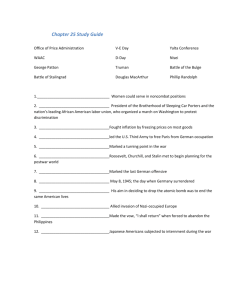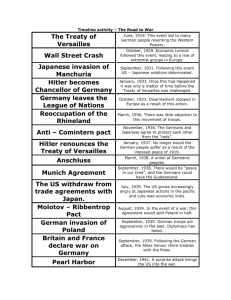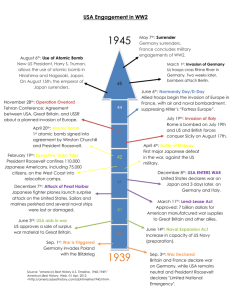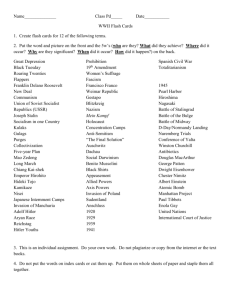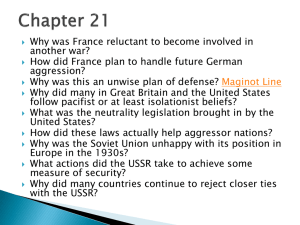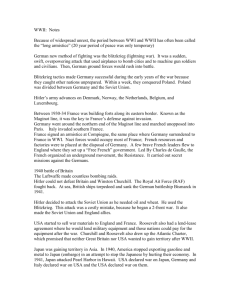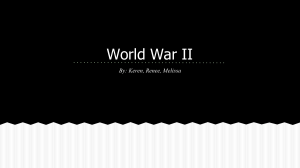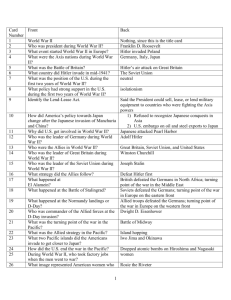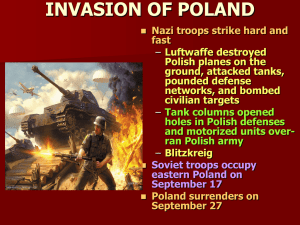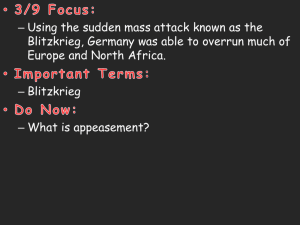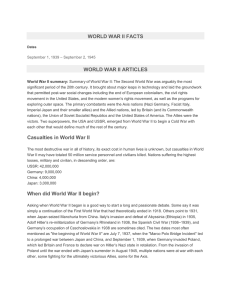Unit I Spiral Exam * Renaissance, Reformation, & Absolute Monarchs
advertisement
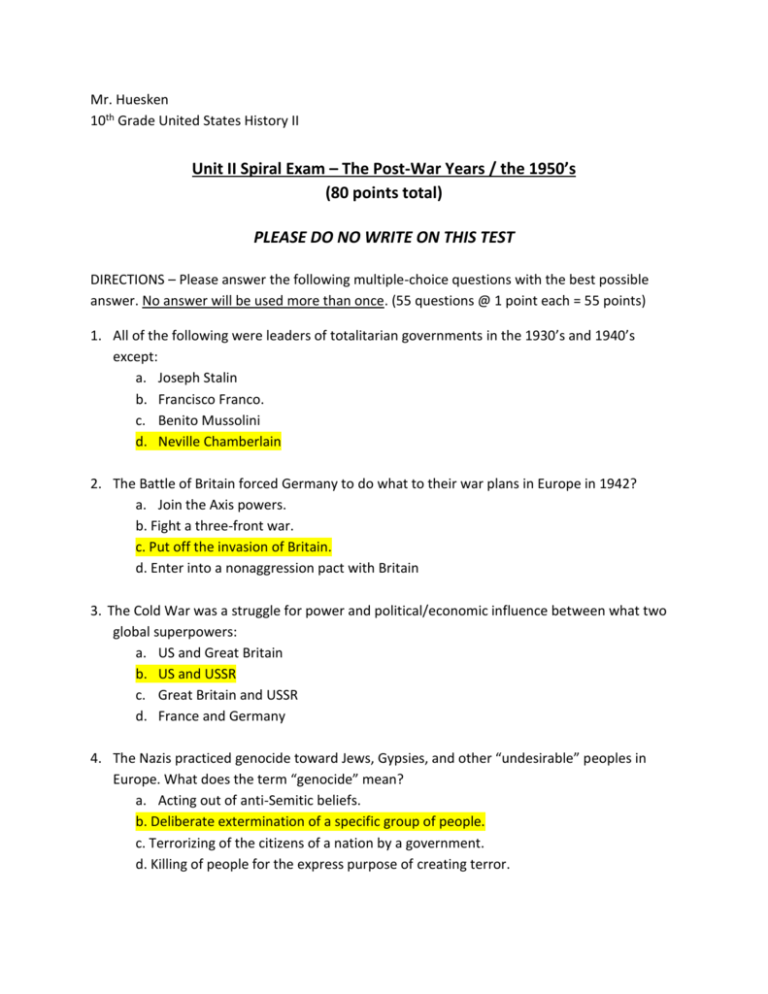
Mr. Huesken 10th Grade United States History II Unit II Spiral Exam – The Post-War Years / the 1950’s (80 points total) PLEASE DO NO WRITE ON THIS TEST DIRECTIONS – Please answer the following multiple-choice questions with the best possible answer. No answer will be used more than once. (55 questions @ 1 point each = 55 points) 1. All of the following were leaders of totalitarian governments in the 1930’s and 1940’s except: a. Joseph Stalin b. Francisco Franco. c. Benito Mussolini d. Neville Chamberlain 2. The Battle of Britain forced Germany to do what to their war plans in Europe in 1942? a. Join the Axis powers. b. Fight a three-front war. c. Put off the invasion of Britain. d. Enter into a nonaggression pact with Britain 3. The Cold War was a struggle for power and political/economic influence between what two global superpowers: a. US and Great Britain b. US and USSR c. Great Britain and USSR d. France and Germany 4. The Nazis practiced genocide toward Jews, Gypsies, and other “undesirable” peoples in Europe. What does the term “genocide” mean? a. Acting out of anti-Semitic beliefs. b. Deliberate extermination of a specific group of people. c. Terrorizing of the citizens of a nation by a government. d. Killing of people for the express purpose of creating terror. 5. The term “blitzkrieg” was a military strategy that depended on what? a. A system of fortifications. b. Out-waiting the opponent. c. Surprise and quick, overwhelming force. d. The ability to make a long, steady advance 6. What was the name of the first artificial satellite sent into outer space? a. Explorer I b. Sputnik I c. Victory II d. Apollo XIII 7. In an effort to avoid a second “world war”, when did the Britain and France adopt a policy of appeasement toward Germany? a. Before the war began. b. When they declared war. c. When the United States declared war. d. After France was invaded and divided. 8. In the study of segregation in the Deep South, historians often cite two (2) types of segregation as key to the running of Southern society. What is the name associated with voluntary segregation done out of custom or habit? a. De facto segregation b. Limited segregation c. Proper segregation d. De jure segregation 9. The United States entered World War II as a direct result of what? a. The attack on Pearl Harbor. b. The invasion and division of France. c. The invasion and division of Poland. d. Attacks on U.S. ships in the Atlantic. 10. Which of the following was a false promise from Hitler not to take any more land in Europe? a. The Munich Pact b. The Atlantic Charter c. The Lend-Lease Act d. The Treaty of Versailles 11. What was the meaning of the Japanese term “kamikaze”? a. “divine wave” b. “holy wind” c. “divine wind” d. “holy war” 12. What was the name of the post-war plan developed by the US to help rebuild many of the countries devastated by World War II (and prevent the spreading of Communism) by the giving of large loans? a. The Truman Doctrine b. Containment c. The Atlantic Charter d. The Marshall Plan 13. The Axis powers’ alliance worried Franklin D. Roosevelt because he saw that the United States, if drawn into the war, would have to a. Join the Allies. b. Fight on U.S. soil. c. Fight on two oceans. d. Take in millions of refugees. 14. With the introduction of “black codes” and other attempts to restrict the rights of African Americans, what fictional character became most often associated with this type of discrimination? a. Tom Thumb b. Joe Bull c. Uncle Tom d. Jim Crow 15. In following a policy of appeasement, Britain and France were taking what controversial action(s)? a. Declaring war on Germany. b. Giving in to Hitler’s demands. c. Entering into a formal defense alliance. d. Pressuring the United States to enter the war. 16. The title of Hitler’s book, Mein Kampf, in English means what? a. “Well-Being.” b. “My Country.” c. “My Struggle.” d. “Master Race.” 17. Hitler’s main method for achieving “lebensraum” or “living space” for the German people was to do what? a. Demand dictatorial power. b. Attack Jews. c. Form a secret police force. d. Conquer other countries. 18. The 1950’s are often known as the decade of the car. What new infrastructure improvement helped to push the desire of every American to have a pair of wheels? a. The founding of General Motors b. The invention of the windshield whipper c. The building of the interstate highway system d. The development of the Pennsylvania Turnpike 19. During the Korean War, what institution helped to raise supplies, money, and troops to fight for the liberation of South Korea from Communist invasion? a. The United Nations b. The League of Nations c. The Warsaw Pact d. NATO 20. What was the name associated with the US Congressional committee which was in charge of searching out and “disloyal” citizens / Communist sympathizers during the 1950’s? a. The Hughes Committee b. The House Committee on Assassinations c. The House of Un-American Activities d. The Senate Foreign Affairs Committee 21. Which of the following was the leader of Japan’s dictatorial government during the 1930’s and 1940’s? a. Adolph Hitler b. Francisco Franco c. Benito Mussolini d. Hideki Tojo 22. The Munich Conference was held to address the problem of a German threat to which nation? a. Poland. b. Hungary. c. Austria. d. Czechoslovakia. 23. A civil rights icon of both then and now, what professional athlete in the 1950’s broke professional baseball’s long standing “color barrier” for African Americans a. Dr. Martin Luther King Jr. b. Rosa Parks c. Emmett Till d. Jackie Robinson 24. Who was the leader of Communist North Korea, who was a resistance fighter for the USSR during World War II and would lead North Korea as a dictator until his death in 1994? a. Mao Zedong b. Ho Chi Minh c. Kim Ill Sung d. Kim Jung Un 25. Which of the following features did Nazi society stress to its citizens? a. Nationalism b. Isolationism c. Individual rights d. A classless society 26. What new innovation and commodity helped to revolutionize entertainment and advertising in the 1950’s and remains a staple of American homes even today? a. The radio b. The magazine c. The television d. The Internet 27. The Weimar Republic was the post-World War I government of what European country? a. France. b. Russia. c. Poland. d. Germany. 28. Which country invaded Rhineland in 1936, touching of a series of events that would eventually lead to the start of World War II? a. Italy b. Japan c. Germany d. the Soviet Union 29. What was the name of the African-American women who refused to give up her seat for a white passenger on a city bus in an act of defiance of Montgomery’s segregated busses? a. Dr. Martin Luther King Jr. b. Rosa Parks c. Emmett Till d. Jackie Robinson 30. Following the end of World War II, Stalin became very obsessed with security and preventing another invasion of the USSR. What was the name of his main strategy he used, which included converting occupied countries into Communist “buffers”? a. “good neighbor” states b. “allied” states c. “satellite” states d. “protective” states 31. Which country invaded China in 1938 as part of a mass campaign of territorial expansion? a. Italy b. Japan c. Germany d. The Soviet Union 32. The Germans first successfully used the blitzkrieg tactics in an attack on what eastern European country, which helped to also set off World War II? a. France. b. Poland. c. Finland. d. The Soviet Union. 33. What was the name of the US Senator who made a career out of claiming to have a list of suspected Communists working within the US government and held committee meetings to investigate these bogus accusations? a. Joseph McCarthy b. Arlen Specter c. Joe Biden d. Ronald Regan 34. Which of the following technologies for the British helped to give them an advantage in the fighting of the Battle of Britain? a. Radar. b. Enigma code. c. British morale. d. More aircraft. 35. What technological development (originally discarded by the Western powers, but utilized by the Japanese) helped make the attack on Pearl Harbor possible? a. Attack submarines b. Heavy bombers c. Accurate radar d. Aircraft carriers 36. Built following the destructive conclusion to the First World War and supported by a massive propaganda campaign, what was the intended purpose of the Maginot Line? a. To protect France from German invasion b. To protect Germany from Austrian invasion c. To protect France from Italian invasion d. To protect Britain from German invasion 37. Which of the following statements most accurately reflects Roosevelt’s feelings toward the events in Europe prior to 1941? a. Agreed with the isolationists and promoted an isolationist policy. b. Wanted to help the Allies, but had to appease U.S. citizens who opposed the war. c. Wanted to avoid the war because he did not see it as a threat to the United States. d. He did not understand the position of isolationists and was eager to join the war. 38. Which of the following musical genres was NOT one of the musical styles that influences the early founding of rock ‘n’ roll in the 1950’s a. Country b. R&B music c. Gospel d. Classical 39. What was the Lend-Lease Act? a. A statement of war aims compiled by Roosevelt and Churchill b. A nonaggression pact between Germany and the Soviet Union c. A policy allowing the president to provide arms to certain foreign countries d. An order to shoot German U-boats on sight 40. What was the name given by Hitler to his supposed “master race”? a. Uebermenschen b. Aryans c. Untermenschen d. Einsatzgruppen 41. Which of the following methods did the German Schutzstaffel (SS) employ to deal with those considered “undesirables” in Nazi Germany or Nazi-controlled areas? a. Death camps b. Deportation c. Concentration camps d. All of the above 42. What phrase was used by the Supreme Court to justify internment of Japanese-Americans following the attack on Pearl Harbor? a. “Military necessity” b. “Military security” c. “National defense” d. “Guaranteed security” 43. The strategy of “island hopping” in the Pacific, which was developed by a joint US ArmyNavy command, involved Allied attacks on what? a. All Japanese-held islands. b. All islands within 500 miles of Japan. c. Only islands that were not well defended and offered strategic advantages. d. Only islands that were Japanese strongholds with fresh water supplies. 44. What legal means did the US government / President Roosevelt use to issue the internment of Japanese-Americans during World War II? a. Signed a bill b. Passed a law c. Issued an executive order d. Proclaimed a national holiday 45. Who was the supreme commander of the Allied forces in Europe during World War II, much to annoyance of our British allies? a. George Patton b. Erwin Rommel c. Bernard Montgomery d. Dwight D. Eisenhower 46. During the 1950’s, many Americans started moving from inside major cities to the outskirts in the hopes of starting a better life with easy-to-buy homes. What were these developments called? a. Levittowns b. Suburbs c. Slums d. Neighborhoods 47. What was the nickname given by the press to the “unfriendly” Hollywood producers, writers, and personalities who refused to testify before Congress in the 1950’s? a. The Hollywood Ten b. The Norfolk Five c. The Memphis Three d. The Chicago Nine 48. Knowing that the Nazis were expecting an invasion of Europe at some point, what region of France was chosen for the D-Day invasion? a. Calais b. Normandy c. Belgium d. Caucasus 49. Following the Battle of Bataan and the Japanese invasion of the Philippines, who went on the Bataan Death March, and why? a. Japanese soldiers, because they refused to surrender b. Allied prisoners of war, because the Japanese forced them to c. Allied soldiers, because it was essential to the success of the “island-hopping” strategy d. Chinese civilians, because they were forced off their land by the Japanese invasion 50. What town was American troops ( like the 101st Airborne Brigade) defending during the Battle of the Bulge, at one point completely cut off from the rest of the Allied army? a. Paris b. Antwerp c. Calais d. Bastogne 51. Known as the “Spartan General”, this general commanded the British forces in North Africa during World War II? a. Eisenhower b. Bradley c. Patton d. Montgomery 52. What are the German troops in North Africa who became legendary for their ability to fight in hostile desert settings? a. Luftwaffe Afrikaner b. Wehrmacht Afrikaner c. Afrika Korps d. Afrika Staffel 53. Who created the theories that lead to the atomic bomb and the creation of the US Manhattan Project? a. Albert Einstein b. Enrico Fermi c. J. Robert Oppenheimer d. Warner von Braun 54. What was the name of the policy used by President Eisenhower that pushed the Soviet Union to the brink of war in order to negotiate from a position of power? a. Containment b. Brinksmanship c. Mass Destruction d. The Mad Man Theory 55. What was the name of the young, fourteen year old African-American male who was killed by Southern whites for allegedly whistling at a white woman? a. Dr. Martin Luther King Jr. b. Rosa Parks c. Emmett Till d. Jackie Robinson
